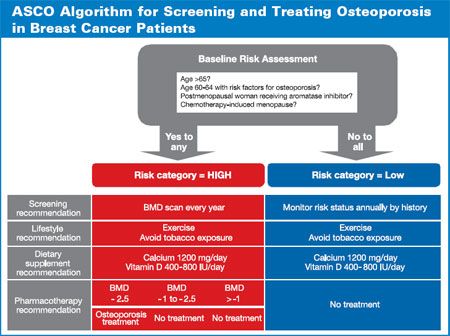Article
Bisphosphonates' Growing Role in Breast Cancer
Author(s):
Intravenous bisphosphonates, often used to treat metastases and bone pain in breast cancer patients, are now being used by clinicians for osteoporosis in these patients—pharmacists need to recommend appropriate screening and treatment.
Dr. LaFleur is a research assistant professor in the department of pharmacotherapy, University of Utah College of Pharmacy Pharmacotherapy Outcomes Research Center.
Nearly one third of women who develop cancer in the United States have breast cancer.1 Should this cancer metastasize, most will eventually have bone involvement.2 Thus, intravenous (IV) bisphosphonates like pamidronate and zoledronate have had a large role in breast cancer, as they treat bone metastases and bone pain.2,3 Now, clinicians also are using bisphosphonates in these patients for a disease that is more familiar to most pharmacists— osteoporosis. Pharmacists need to understand breast cancer patients' risks for osteoporosis and recommend appropriate screening and treatment.
The Connection Between Osteoporosis and Breast Cancer
Breast cancer treatment increases osteoporosis risk in 2 ways. One cause is development of chemotherapyinduced amenorrhea in premenopausal women.4 Most patients treated with a common regimen (cyclophosphamide, methotrexate, and fluorouracil) for estrogen- receptor—positive (ER+) or negative breast cancer developed amenorrhea.4 These women have rapid and sustained bone loss.5 A second cause exists only in women with ER+ cancers. In these women, tamoxifen, which has been the gold standard for adjuvant endocrine therapy for more than 2 decades, is now being replaced by aromatase inhibitors (anastrazole, letrozole, examestane), which do not protect patients against osteoporosis as well as tamoxifen. In fact, their estrogen-suppressing effects actually increase the risk.6-8 Aromatase inhibitors reduce cancer recurrence by as much as an additional 30% over tamoxifen.9,10 Their risk of serious adverse events like ischemic stroke, endometrial cancer, and venous thromboembolism is lower.6
Screening and Treating Osteoporosis in Breast Cancer
The American Society of Clinical Oncology (ASCO) recently issued a new guideline for osteoporosis screening and treatment in breast cancer.3 It stresses the need for oncology clinicians to expand their roles to evaluating bone health routinely and regularly.3 The breast cancer—specific guideline was based on a more general osteoporosis guideline produced by the US Preventive Services Task Force (USPSTF).11 The USPSTF recommends routine bone mineral density (BMD) screening in women at high risk for osteoporosis. The USPSTF considers certain women at high risk—those older than age 65, or between 60 and 64 and having other risk factors like a family history of osteoporosis, or those with a low body weight (<154 lb) or a prior fragility fracture. For breast cancer patients, ASCO adds 2 more high-risk categories: (1) postmenopausal women (of any age) receiving aromatase inhibitors, and (2) younger women with chemotherapy-associated premature menopause.
The Figure shows the ASCO algorithm for recommending BMD screening, lifestyle changes, and treatment interventions in women with and without these high-risk designations. Like the USPSTF, ASCO states that clinicians should encourage all patients to undertake preventive measures. First, eating a healthy diet supplemented with calcium and vitamin D maintains adequate calcium to continually rebuild bone. Second, regular exercise strengthens bone and maintains high bone density, and, third, smoking avoidance helps prevent premature bone loss. These measures are recommended to all patients. High-risk patients should also receive BMD scans every year, and patients with BMD T-scores at or below the threshold for osteoporosis (-2.5) should receive treatment.
Figure

ASCO = American Society of Clinical Oncology; BMD = bone mineral density.
Adapted from reference 3.
Osteoporosis Treatments in Breast Cancer
A few of the agents approved by the FDA for osteoporosis prevention and treatment require special consideration in women with breast cancer. Raloxifene should be avoided in women who have had 5 years of treatment with tamoxifen because of concerns about higher cancer recurrence and mortality rates.3,12 Teriparatide also is not recommended, because it caused osteosarcoma in animals.3,13 Estrogen plus progestin is no longer recommended for osteoporosis prevention because of the increased risk for serious life-threatening adverse events, including breast cancer.3,14 Generally, due to strong safety profiles and a larger pool of evidence supporting their benefits, bisphosphonates are the treatment of choice in patients with and without breast cancer.3
Patient Adherence
As in many symptomless chronic diseases, patient adherence and persistence with osteoporosis treatment are poor. A recent meta-analysis showed that only about half of patients persist with bisphosphonates more than 6 months, and most discontinue after the first month.15 Poor adherence is alarming; increasing evidence shows that patients need at least 6 months exposure to reap treatment benefits.16 The newer oral bisphosphonates' longer dosing intervals may improve patient adherence.17 For patients who have difficulty persisting with oral bisphosphonates, even with longer dosing intervals, the once-yearly bisphosphonate zoledronate may be an alternative.18 Zoledronate lacks the oral bisphosphonates' administration restrictions but must be infused intravenously; most physicians' offices are unable to infuse IV drugs. Additionally, a flu-like infusion reaction occurs after a first dose in about 16% of patients.
Counseling Points for Pharmacists
Because the risk of osteoporosis increases in patients with breast cancer, pharmacists need to be aware of the guidelines for preventing fractures, as well as counseling points for these patients.
- Talk with your patients with breast cancer about their risk for osteoporosis, and encourage those with chemotherapy- induced amenorrhea or aromatase inhibitor treatment to seek out yearly BMD screening
- Counsel all patients about the importance of exercising, eating right, avoiding tobacco smoke exposure, and taking calcium and vitamin D supplements to strengthen bones
- Recommend a bisphosphonate as first-line treatment in patients with breast cancer—induced osteoporosis
- Recommend agents with longer dosing intervals for patients with poor adherence
Table
FDA Approved Therapies for Osteoporosis: Their Role in Breast Cancer Patients
Approved Treatments
Dose Regimens for Prevention and Treatment
Considerations for Breast Cancer Patients
Adverse Effects
Bisphosphonates
Alendronate
5 mg by mouth daily
35 mg by mouth weekly
70 mg by mouth weekly
Recommended
Upper GI irritation, myalgias, arthralgias, rarely osteonecrosis of the jaw
Ibandronate
2.5 mg by mouth daily
150 mg by mouth monthly
Risedronate
5 mg by mouth daily
35 mg by mouth weekly
Zoledronate
5 mg by intravenous infusion given over 15 minutes yearly
Selective estrogen receptor modulators
Raloxifene
60 mg by mouth daily
Do not use after tamoxifen due to occurrence of cross resistance
Hot flushes, leg cramps, deep vein thrombosis
Parathyroid hormone
Teriparatide
20 U subcutaneously daily
Do not use in breast cancer patients due to osteosarcoma in animal models
Dizziness, leg cramps, hypercalcemia
Estrogen +/- progestin
Varies
Do not use in breast cancer or non—breast cancer patients due to adverse effects
Breast tenderness, vaginal bleeding, coronary heart disease, stroke, pulmonary embolism, breast cancer
Calcium regulators
Calcitonin
200 U in one nostril daily
None
Rhinitis
GI = gastrointestinal.
Adapted from reference 3.
References
- Landis SH, Murray T, Bolden S, Wingo PA. Cancer statistics, 1998. CA Cancer J Clin. 1998;48:6-29.
- Hillner BE, Ingle JN, Berenson JR, et al. American Society of Clinical Oncology guideline on the role of bisphosphonates in breast cancer. American Society of Clinical Oncology Bisphosphonates Expert Panel. J Clin Oncol. 2000;18:1378-91.
- Hillner BE, Ingle JN, Chlebowski RT, et al. American Society of Clinical Oncology 2003 update on the role of bisphosphonates and bone health issues in women with breast cancer. J Clin Oncol. 2003;21:4042-57.
- Bines J, Oleske DM, Cobleigh MA. Ovarian function in premenopausal women treated with adjuvant chemotherapy for breast cancer. J Clin Oncol. 1996;14:1718-29.
- Shapiro CL, Manola J, Leboff M. Ovarian failure after adjuvant chemotherapy is associated with rapid bone loss in women with early-stage breast cancer. J Clin Oncol. 2001;19:3306-11.
- Howell A, Cuzick J, Baum M, et al. Results of the ATAC (Arimidex, Tamoxifen, Alone or in Combination) trial after completion of 5 years' adjuvant treatment for breast cancer. Lancet. 2005;365:60-2.
- Winer EP, Hudis C, Burstein HJ, et al. American Society of Clinical Oncology technology assessment on the use of aromatase inhibitors as adjuvant therapy for postmenopausal women with hormone receptor-positive breast cancer: status report 2004. J Clin Oncol. 2005;23:619-29.
- Coleman RE. Effect of anastrozole on bone mineral density: 5-year results from the 'Arimidex', Tamoxifen, Alone or in Combination (ATAC) trial. In: Journal of Clinical Oncology, 2006 American Society of Clinical Oncology Annual Meeting Proceedings Part I. 2006;24(18S):511. wwwascoorg/ASCO/Abstracts+%26+Virtual+Meeting/~ Accessed 8 March 2008.
- Goss PE, Ingle JN, Martino S, et al. A randomized trial of letrozole in postmenopausal women after five years of tamoxifen therapy for early-stage breast cancer. N Engl J Med. 2003;349:1793-802.
- Coombes RC, Hall E, Gibson LJ, et al. A randomized trial of exemestane after two to three years of tamoxifen therapy in postmenopausal women with primary breast cancer. N Engl J Med. 2004;350:1081-92.
- Screening for osteoporosis in postmenopausal women: recommendations and rationale. Am Fam Physician. 2002;66:1430-2.
- Fisher B, Dignam J, Bryant J, Wolmark N. Five versus more than five years of tamoxifen for lymph node-negative breast cancer: updated findings from the National Surgical Adjuvant Breast and Bowel Project B-14 randomized trial. J Natl Cancer Inst. 2001;93:684-90.
- Cranney A, Guyatt G, Griffith L, Wells G, Tugwell P, Rosen C. Meta-analyses of therapies for postmenopausal osteoporosis. IX: Summary of meta-analyses of therapies for postmenopausal osteoporosis. Endocr Rev. 2002;23:570-8.
- Rossouw JE, Anderson GL, Prentice RL, et al. Risks and benefits of estrogen plus progestin in healthy postmenopausal women: principal results From the Women's Health Initiative randomized controlled trial. JAMA. 2002;288:321-33.
- Kothawala P, Badamgarav E, Ryu S, Miller RM, Halbert RJ. Systematic review and meta-analysis of real-world adherence to drug therapy for osteoporosis. Mayo Clin Proc. 2007;82:1493-501.
- Weycker D, Macarios D, Edelsberg J, Oster G. Compliance with osteoporosis drug therapy and risk of fracture. Osteoporos Int. 2007;18:271-7.
- Lewiecki EM. Long dosing intervals in the treatment of postmenopausal osteoporosis. Curr Med Res Opin. 2007;23:2617-25.
- Black DM, Delmas PD, Eastell R, et al. Once-yearly zoledronic acid for treatment of postmenopausal osteoporosis. N Engl J Med. 2007;356:1809-22.
Newsletter
Stay informed on drug updates, treatment guidelines, and pharmacy practice trends—subscribe to Pharmacy Times for weekly clinical insights.






